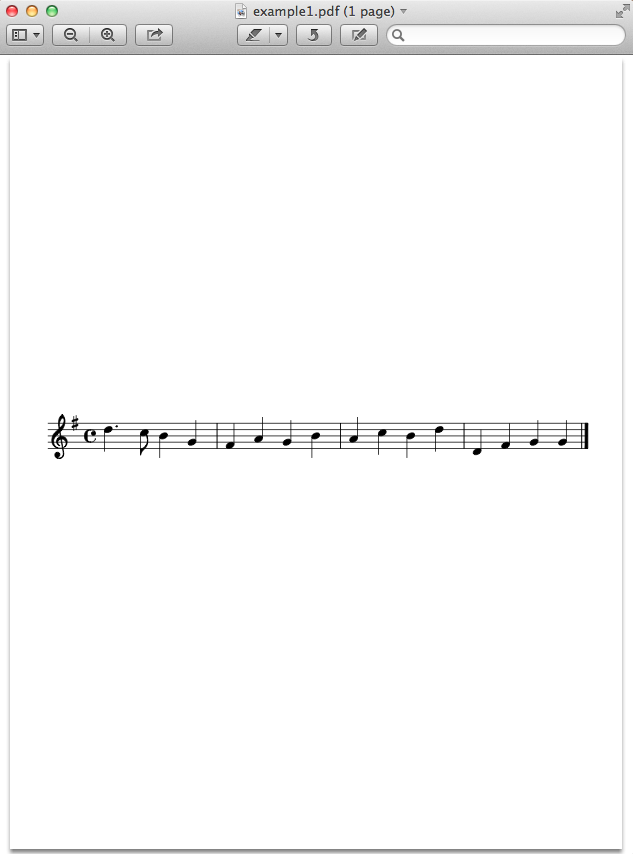Step-by-step guide to entering music into SCORE 4
This guide illustrates the steps necessary to create, save, and print this example music in SCORE 4:

Open Boxer.app
This will depend on your operating system and version of SCORE. For this guide, SCORE 4 is being used in OS X using the MS-DOS emulator Boxer. If you have SCORE 4 (MS-DOS version of SCORE) installed within Boxer, you would double click on the SCORE 4 icon on the Desktop or in the Dock. Here is an example of what it looks like in the Dock:

Click on the Scor4 icon to run Boxer.app. A DOS window should appear:
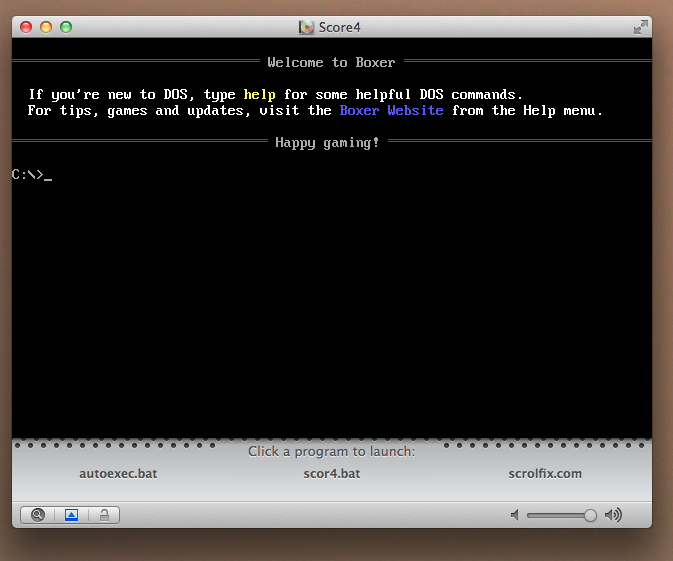
Start SCORE
In the DOS terminal, type:
scor4
To start the SCORE 4 editor program.
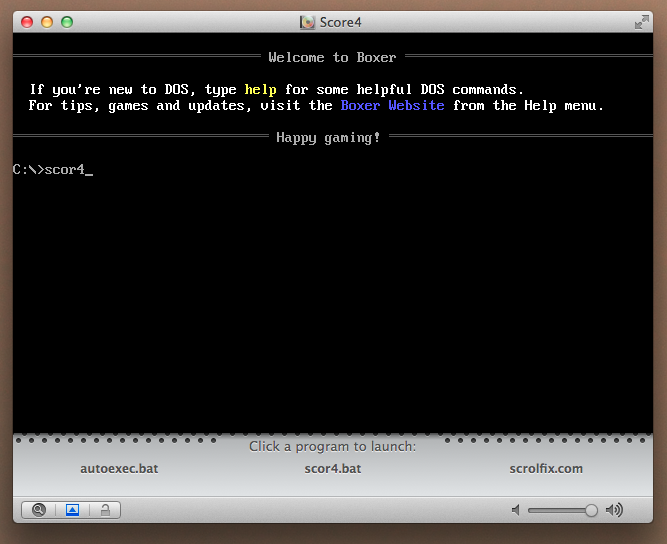
The first page is a splash screen:
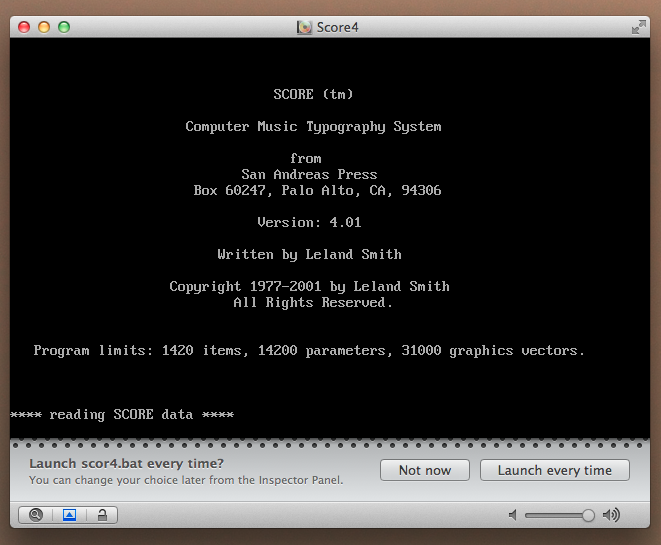
The splash screen will display for a couple of seconds. If you want to skip the spash screen faster, press the space bar. You should end up in the main editor for SCORE:
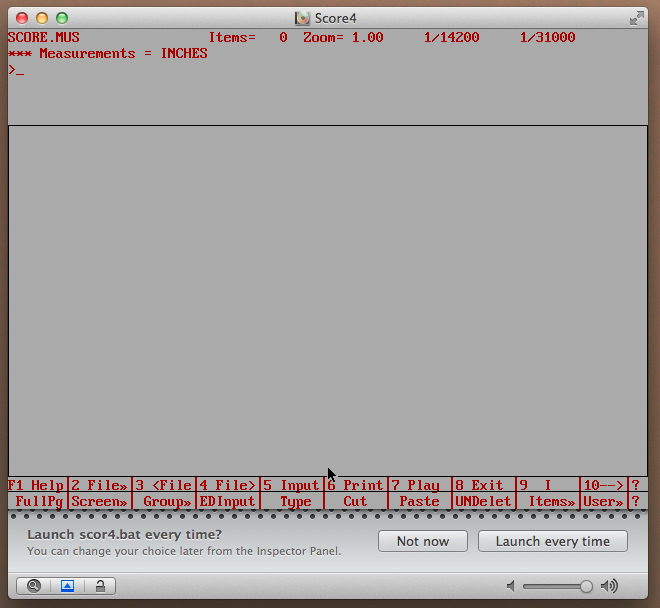
Inputting a line of music
To start entering a line of music, type "INP" on the SCORE command line:
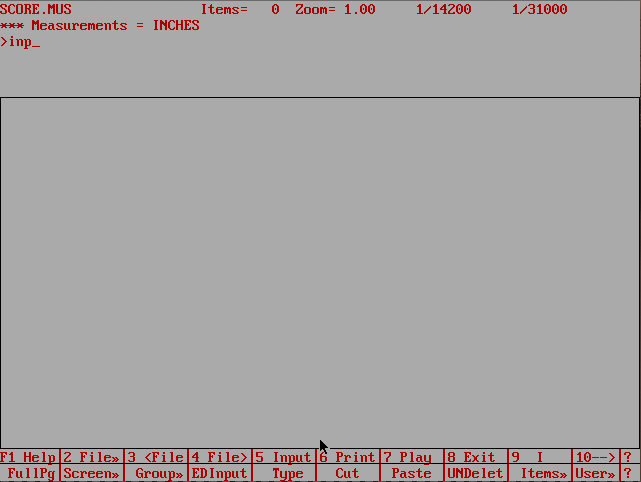
Press the ↵ Enter key and you will see a menu which controls the parameters for a line of music in Input Mode:
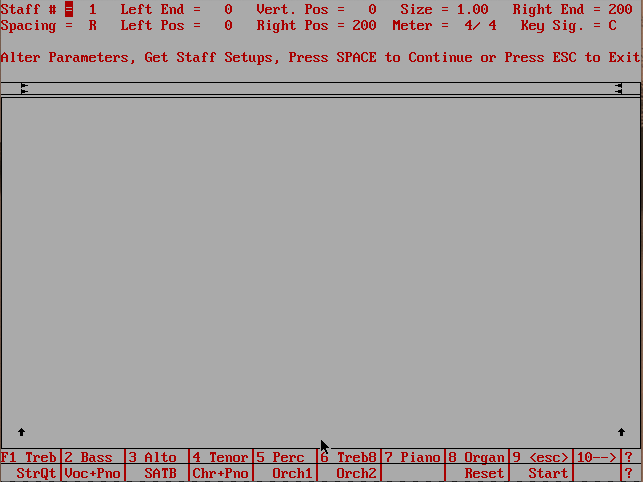
You can use the↑+↓ keys to scroll through the 10 starting parameters. For now, all of the defaults can be used. The first one called "Staff #" is set to 1 which is the bottom staff on the page. You would set this to two for the second staff and so on (typically up to 12 staves on a page).
Starting the 5-stage entry process
Pitch Stage
Press the space key to start entering the 5-stage user input code for the music on the line. After pressing space, here is what the text on the first line should look like for the example music:
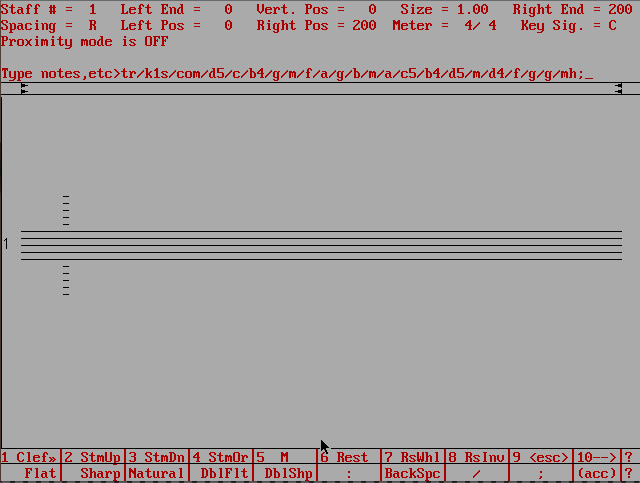
The pitch-stage text is shown above. When finished with text, type a semicolon and then ↵ Enter. You can press enter in the middle of the pitch data to break long lines into shorter (there is an overflow bug when a line exceeds 256 characters).
Rhythm Stage
After pressing return at the end of the pitch stage, rhythms are specified. Here is what the text for the rhythm stage is:
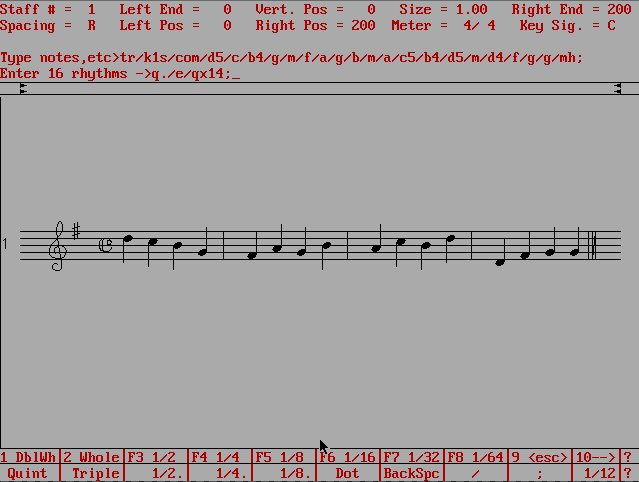
Notice that the pitches from the pitch stage are visible, but they are temporarily displayed as quarter notes. The Rhythm stage is finished by typing a semi-colon (;) and then return.
Marks Stage
After the rhythms have been entered, the music will have the correct rhythm. Numbers will also be temporarily placed above the music. These numbers are used to input data from the next three stages. In this case there is no additional data to enter, so type g+↵ Enter to end the 5-stage entry process.
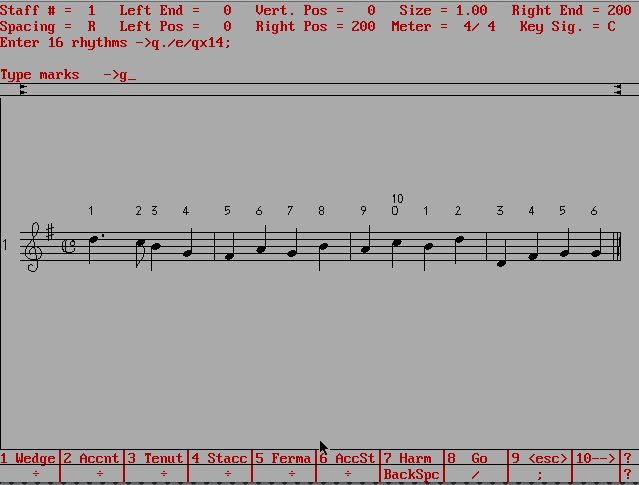
Saving input data
After finishing a 5-stage input process for a line of music, SCORE will ask if you want to save the data to a file. The data it wants to save is the actual text that you typed. This data is typically not saved in normal use of SCORE, but is useful if you need to re-enter lots of music with a similar pattern. So in general it is safe not to save at this point, but useful when learning score (so you can recover the music if you mess up editing it).
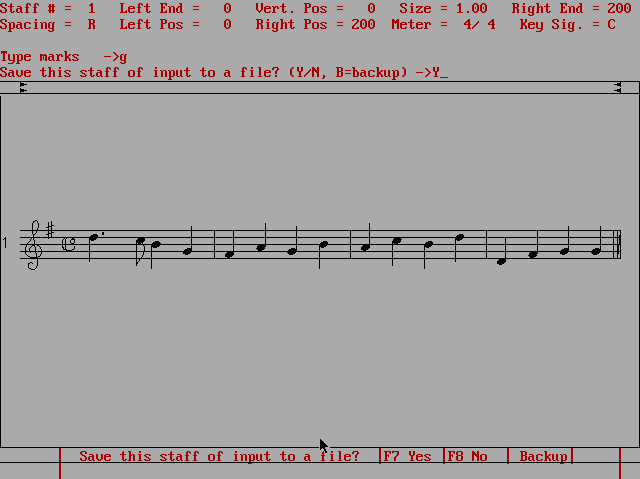
After saving the file, you will see the new file in the File Browser (depending on where the Boxer files are being saved):
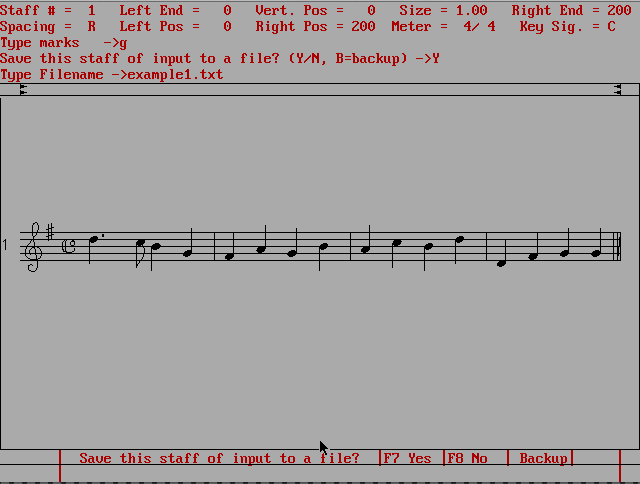
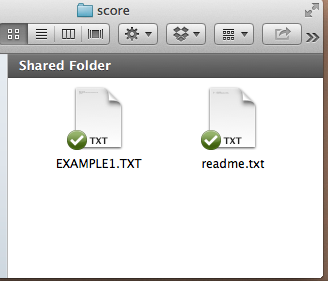
Press esc to finish inputting music and return to command mode.
Here is the contents of EXAMPLE1.TXT if you save the input data:
IN1 0 0 1.0000 200 0 200 TR/K1S/COM/D5/C/B4/G/M/F/A/G/B/M/A/C5/B4/D5/M/D4/F/G/G/MH; Q./E/QX14; G
Lineup & Justify
After entering music in SCORE, it is usually in a linear rhythmic proportion (half-notes take 1/2 the space of a quarter note). Musical spacing is typically logarathmic (exponential) with each larger duration taking about 1.5 times the space of half its duration (instead of a factor of 2 in linear spacing). Therefore it is useful to run the LJ command by typing the following in command mode:
LJ 1 1
The first line "LJ" runs the lineup-and-justify function on the music. The second line are the parameters to LJ, with the first number being the starting staff #, and the second number is the number of staves to consider when lining up. Press ↵ Enter after each of the above lines. SCORE will ask if you really want to do this, so you will also have to press ↵ Enter or any other key other than B to run the command:
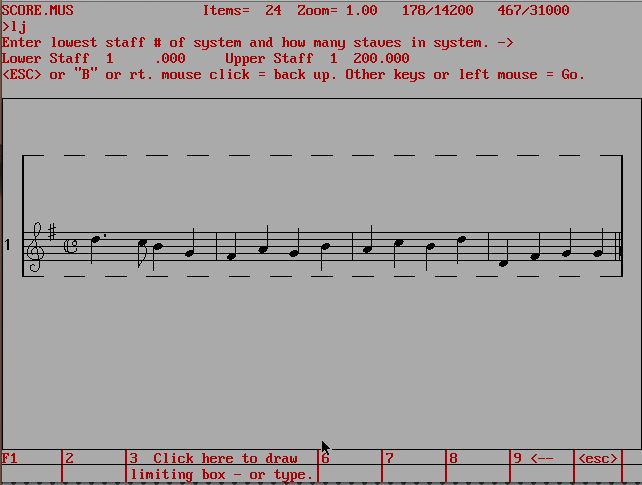
Final result:
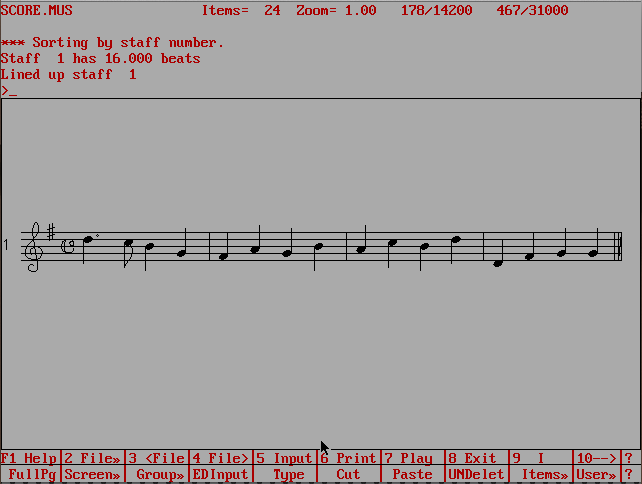
In this case most of the notes are quarter notes, but you should be able to notice that the distance between the eighth note and the next note was increased slightly.
Saving files
To save the contents of the editor type:
SA EXAMPLE1
This will save to the filename "EXAMPLE1.MUS". You can also include the .MUS on the above line, or you can change the default extension. Typically .PAG is also used to indicate the file contains music for an entire page. The data is in a binary format, so don't use the .TXT extension since that will be confusing.

After you have saved the music, the name of the file being edited will show up in the top left corner of the editor. Also note the "(SAVED)" status text in the top right meaning that the contents of the editor currently matches to the content of the saved file. When the editor content changes, and you want to update the file type:
SM
This will save the current editor contents to the file listed in the top left corner of the main editor window.
At this point you can type
EXIT
to leave the SCORE editor and go back to the MS-DOS terminal.
Loading a binary file
To load a .MUS file into the SCORE editor, type "G" and then the filename, such as:
G EXAMPLE1.MUS
If you do not give an extension, .MUS will be used as the default.
Loading a text file
To reload the user-input data, use the "RE" command:
RE EXAMPLE1.TXT
This will load the input data before LJ was applied. Do not mix up the two type of file loading. Remember that "G" (Get) is for binary files, and "RE" is for ASCII files.
PMX files
The binary files such as EXAMPLE1.MUS can also be saved in an ASCII equivalent by typing the PMX command, and then a filename at the prompt. For example, try PMX on the data in the editor. Typically the extension given to such files is .PMX, but .TXT also works (and allows easier opening in the file browser as a text file.
Playing
SCORE can play the music in the editor (useful for prooflistening). Type the word "PLAY" (or click on the PLAY button at the bottom of the screen in command mode or press F7 key in command mode) to go to the play menu (and then press the space bar to start playback over MIDI.
Printing
Type PRINT in command mode to go to the print menu:

Type
1 EXAMPLE1
To save to the Encapsulated PostScript filename EXAMPLE1.EPS (.EPS is added by default, or you can type into name yourself).
Set the left and bottom margins by typing a 4 followed by the margins in inches (in this case):
4 .5 5.5
In the above example menu item #4 (margins) is set to 0.5 inches on the left, and 5.5 from the bottom of the page.
Type G+↵ Enter to start printing. A filed called EXAMPLE1.EPS will be visible in the same location as your EXAMPLE1.MUS file.
EPS to PDF
On the command-line, you can convert the EPS file to PDF with GhostScript (if installed):
ps2pdf -sPAPERSIZE=letter EXAMPLE1.EPS example1.pdf
Or you can just double-click on the EPS file to view in Preview.app. The EPS file will have bounding box display only, while the PDF will be full page:
EPS view:
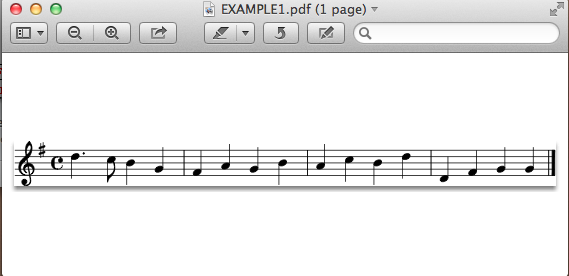
PDF view:
